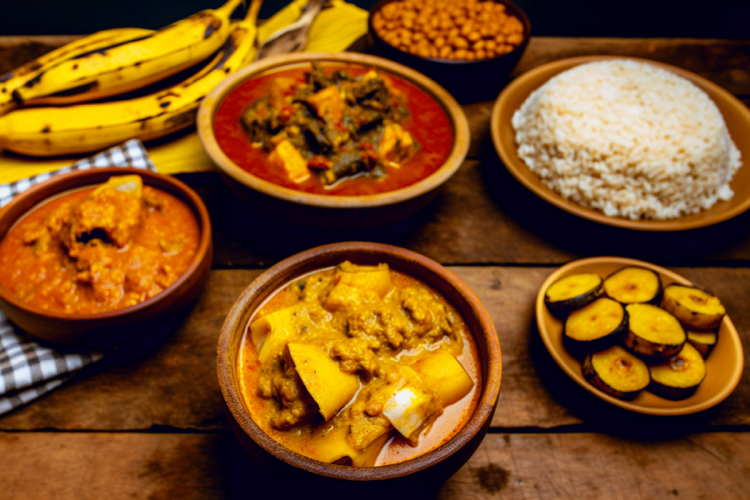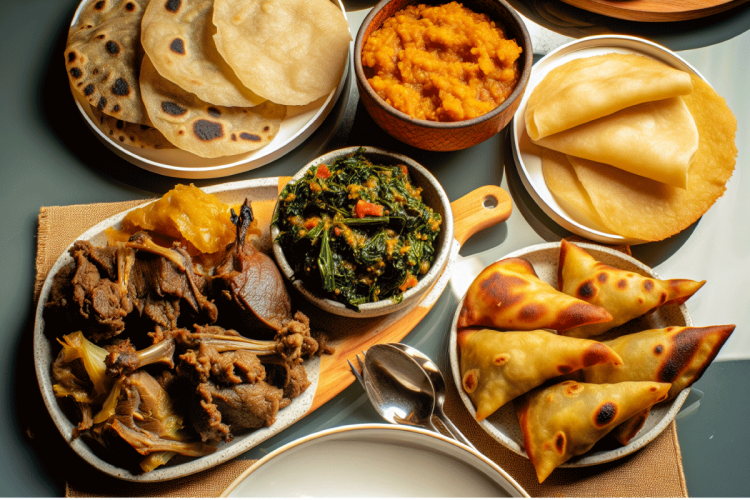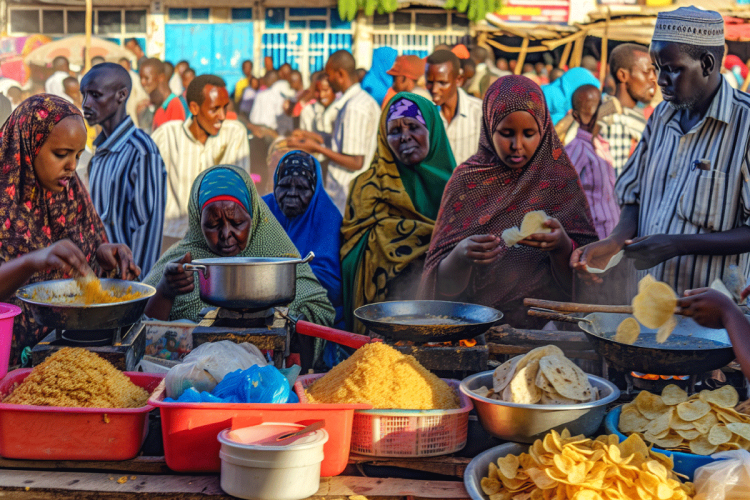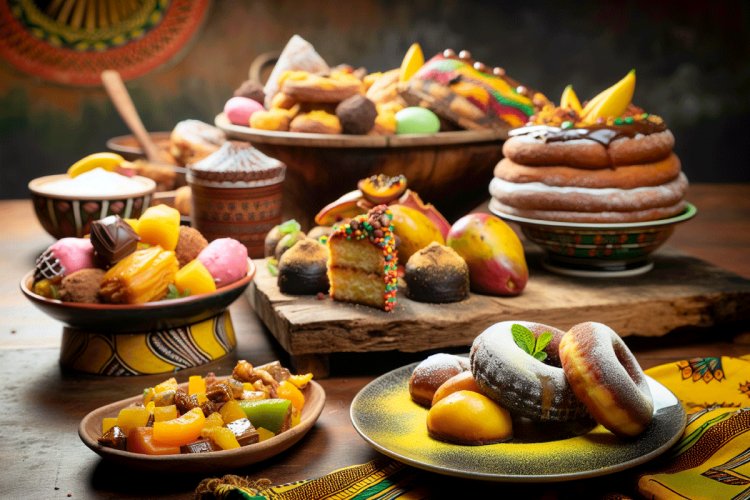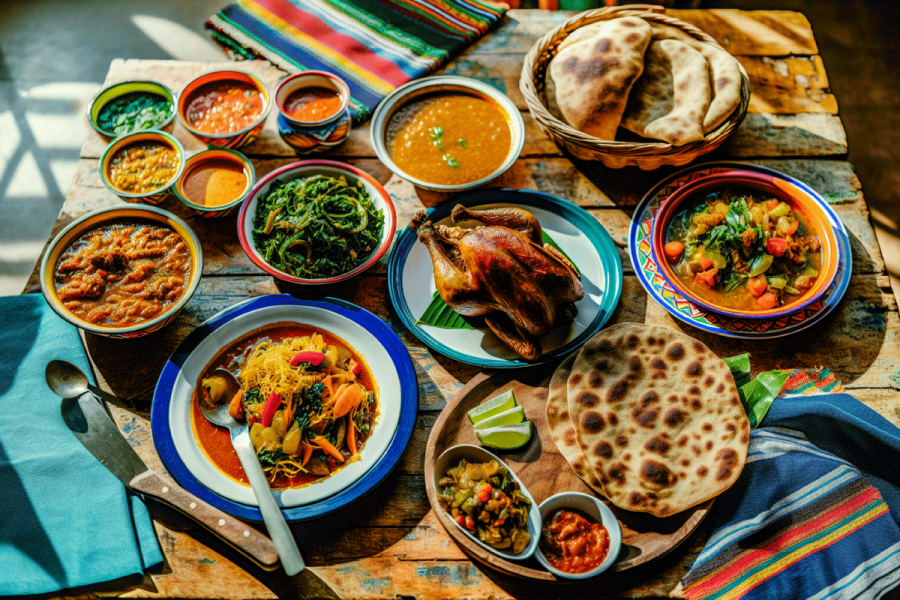Explore the vibrant flavors of East Africa food
East Africa food tells a story of culture, community, and adventure on a plate.
Staples like ugali and succulent nyama choma weave narratives of shared heritage and diverse influences. This exploration will take you from Kenya’s grilled delights to the coconut-rich curries of the Swahili coast, revealing how spices, produce, and tradition shape this vibrant cuisine. Prepare to savor the tastiest food in Africa and the authentic flavors of a region where every meal is a celebration of life.
East African food
- East African cuisine is diverse, with each country offering unique dishes influenced by local ethnic groups, history, geography, and cultures, often revolving around staple ingredients like maize, coconut milk, spices, and fresh produce.
- Staple ingredients such as maize (for ugali and githeri), coconut milk (for coastal recipes), and a variety of spices (like cumin, turmeric, coriander) are central to authentic East African flavors and culinary practices.
- Street food is a vibrant aspect of East African food culture, with popular items including samosas, mandazi, mishkaki, and chips mayai, reflecting regional tastes and offering a glimpse into the local everyday life and cuisine.
A flavorful tour of East African countries
East Africa’s culinary landscape mirrors the diversity of its people and geography. Each country has its own unique cuisine, shaped by its history, geography, and the cultures of its people. Communal dining, a common practice in many African countries, fosters a sense of togetherness, as families and friends often share meals.
East African cuisine, defined by vibrant flavors and unique traditions, preserves its heritage and authenticity through recipes handed down across generations.
Kenya is a melting pot of flavors
Kenya’s cuisine is a melting pot of influences from the country’s approximately 40 different ethnic groups. From the Maasai community’s focus on cattle and goat by-products to the Kikuyu and Gikuyu’s crop-based dishes like irio, Kenya’s culinary diversity is truly impressive.
Swahili dishes, in particular, gain an extra layer of complexity from the use of aromatic spices like cumin, turmeric, coconut, coriander, and tamarind.
Tanzania brings in coastal delights and hearty staples
Tanzanian cuisine is a rich hybrid of flavors heavily influenced by Indian cooking. The coastal region of Zanzibar is celebrated for its ‘mchuzi wa samaki,’ a fish and coconut curry, and similar dishes using the abundant local seafood.
‘Wali na Maharage,’ a combination of rice and beans cooked in coconut milk with tender meat, and the nourishing ‘Mtori’ stew, serve as cornerstones of Tanzanian comfort food.
Uganda has plantains, matoke, and street food favorites
Uganda’s cuisine is characterized by its wide use of plantains, particularly in the national dish, matooke. This dish consists of steamed and mashed green bananas, which are often served with various savory sauces. Ugandans also consume a variety of other staple crops including cassava, sweet potatoes, yams, beans, peas, and groundnuts.
These ingredients are often incorporated into stews that are typically served with posho, a dense cornmeal product, creating a satisfying and balanced meal.
Rwanda and Burundi have simple yet flavorful dishes
The cuisines of Rwanda and Burundi feature simple dishes that are rich in flavor, often incorporating local ingredients such as beans, plantains, and vegetables. In Rwanda, flavorful dishes like mtori and brochettes incorporate a variety of beans and vegetables, with meat being reserved for special occasions.
Burundi’s cuisine is also centered around plantains, beans, and hearty stews. The frequent use of onions, tomatoes, and chilies adds freshness and flavor to these simple yet satisfying dishes.
Somalia has fusion cuisine with global influences
Somali cuisine is a fusion of flavors where Indian influence is evident in dishes like spicy marinated chicken enriched with coconut milk, exemplifying the blend of heat and sweetness. Djiboutian cuisine, often grouped with Somali cuisine, incorporates a rich palette of spices including saffron, cinnamon, cardamom, and nutmeg, primarily in fish dishes cooker Yemeni-style.
Kachumbari, a beloved salad in Somali cuisine that consists of tomatoes, onions, cilantro, dressed with lime or lemon juice, oil, salt, and pepper, akin to Mexican pico de gallo.
Staple ingredients in East African cooking
Staple ingredients play a central role in maintaining the authenticity of East African cuisine. Some of these staple ingredients include:
- Maize
- Coconut milk
- Spices
- Fresh, locally sourced ingredients
These ingredients not only add depth and warmth to a variety of savory and sweet preparations but also contribute to the cuisine’s vibrant and authentic flavors.
Maize is the backbone of many dishes
Maize, a staple across East Africa, forms the foundation of dishes like Kenya’s ugali and githeri. The cultivation of maize was vastly expanded during the British colonial era, making maize meal more accessible.
White maize meal or maize flour is the preferred type for preparing Ugali, a dish that has various names across sub-Saharan Africa, reflecting the widespread consumption and importance of maize in the region.
Coconut milk is the creamy base for coastal recipes
Coconut milk is widely used in East African cooking, particularly in coastal recipes. Known as nazi or madafu in the region, coconut milk creates a perfectly balanced creamy texture in curries and stews.
Coconut water, a favored refreshment in East Africa, is particularly popular during spice tours in Zanzibar.
Spices: are the heart of East African flavor
Spices are the heart of East African flavor. From the rich hybrid of flavors in Tanzanian cuisine, influenced by its historical trade with the Arab world and India, to the iconic spice blends of Ethiopian and Eritrean cuisine, spices lend essential depth and warmth to East African dishes.
Cumin, garlic, ginger, cinnamon, and paprika, along with ingredients like fenugreek seeds and tamarind paste, are commonly used, contributing to the distinct flavors of the cuisine.
Fresh produce with locally sourced and seasonal ingredients
Fresh, locally sourced ingredients distinguish East African cooking. In Uganda, most people, except for those in city centers, produce their own food, reflecting a strong tradition of local sourcing. Tanzanian cuisine often features bananas and coconuts, ingredients which are abundant in the country and heavily used in local recipes.
Sukuma wiki, known as collard greens, is a versatile and nutritious ingredient often paired with a staple like ugali in East African meals. The East African salad Kachumbari, made with fresh vegetables like tomatoes, onions, and cilantro, zested with lime or lemon juice, is a prime example of seasonal ingredients being used in regional dishes.
Must-try East African dishes
A plethora of delectable dishes await anyone exploring East African cuisine. Some of the must-try dishes include:
- Nyama choma: grilled meat experience
- Ugali: satisfying staple unleavened flatbread
- Chapati: delicious flatbread
- Sukuma wiki: nutritious greens
- Samosas: tasty street food treat
The region offers a culinary journey like no other.
Nyama choma or the ultimate grilled meat experience
Grilled goat meat, a specialty known as Nyama Choma, enjoys immense popularity in Tanzania and Kenya. The term ‘Nyama Choma’ translates to ‘barbecue meat’ in Kiswahili. Authentic Nyama Choma is often seasoned with salt and pepper, and sometimes marinated with onions, garlic, ground ginger, hot pepper, and lemon juice.
For an optimal taste experience, Nyama Choma should be cooked as follows:
- Cover the meat with aluminum foil.
- Cook over heat for about an hour and a half.
- It’s traditionally consumed with fingers.
- It is commonly accompanied by the salad Kachumbari and Ugali.
Ugali is a versatile and satisfying staple
Ugali, a staple food in the Tanzanian diet, is a cornmeal porridge widely enjoyed across East Africa. The essential ingredients include water, salt, and white cornmeal, and the cooking process involves combining and cooking these ingredients until they form a thick and smooth consistency.
Ugali is traditionally eaten by hand; a person pinches off a piece, rolls it into a ball, makes an indentation with the thumb, and then dips it into meat, vegetables, or sauces. As a versatile dish, Ugali pairs well with a variety of accompaniments, such as meat stews, vegetable dishes, greens, or it can be enjoyed with soured milk.
Chapati is a delicious unleavened flatbread
Chapati in East Africa, a flaky, layered flatbread made with white flour and oil, stands apart from the traditional whole wheat Indian chapati. The ingredients for making East African chapati include:
- all-purpose flour
- water
- oil
- salt
These ingredients are combined to form a dough. Chapati dough is divided into balls, rolled thin, brushed with oil and shaped into coils prior to being flattened and cooked on a dry skillet until it develops air bubbles and brown spots.
Served warm, chapati often pairs with stews or can be enjoyed on its own, being a versatile element in East African cuisine.
Sukuma wiki are nutritious greens with a kick
Sukuma Wiki, a greasy, nutritious green dish, forms a daily staple across East Africa. It is commonly served with a side of kachumbari (tomatoes and onions), hot chilies, and a bottle of East African style tomato chili sauce.
Samosas: are a tasty street food treat
A samosa, typically filled with beef, chicken, fish, or vegetables, is a triangular pastry snack. To make samosas, you will need the following ingredients:
- Thin samosa wrappers
- Ground beef or chicken
- Potatoes
- Onions
- Peas
- Curry powder
- Oil for frying
- Salt
- Pepper
These ingredients are essential for making the delicious savory pastry with a savory sauce.
This popular dish is a well-known street food in Tanzania, available at a myriad of locales including market stalls and local eateries across cities and rural areas.
East African street food culture
Vibrant East African street food, reflecting local flavors and culinary practices, forms a significant part of the region’s culture. Some popular street foods in East Africa include:
- Samosas
- Mandazi (sweet doughnuts)
- Mishkaki (meat kebabs)
- Chips mayai (omelette with French fries)
These street foods provide a delectable taste of East Africa’s culinary diversity.
Rolex is a Ugandan favorite
A beloved street food in Uganda, a Rolex meal consists of a rolled chapati filled with a mix of eggs, avocado, onions, tomatoes, seasoned with salt and pepper. The concept of the Rolex originated from a chapati seller in the Busoga region and gained popularity especially in Wandegeya, near Makerere University, propelled by student demand.
Now a pervasive part of Ugandan cuisine, the Rolex is acclaimed for its ease of consumption, affordability, and savory taste.
Chips mayai are a Tanzanian twist on French fries
Chips Mayai, a Tanzanian omelette, incorporates French fries into the egg mixture. This dish is a well-known street food in Tanzania, available at a myriad of locales including market stalls and local eateries across cities and rural areas.
The simplicity of the dish, combining beloved elements of French fries and eggs, makes Chips Mayai a comforting favorite among Tanzanians.
Mishkaki are succulent meat kebabs
Mishkaki, succulent skewered and grilled meat kebabs, are a beloved form of street food throughout East Africa. Commonly made from beef, Mishkaki also frequently includes goat meat, which is a popular meat choice in the region.
For optimal grilling results, meat in East African cuisine should be cooked gently over a low charcoal heat to ensure it is thoroughly cooked without burning.
Mandazi is a sweet and satisfying treat
Mandazi, a type of fried bread, holds prominence in East African cuisine, especially in Kenya and Tanzania. Often described as African “doughnuts,” mandazi are slightly sweet with a hint of cardamom or other spices such as cinnamon but are not glazed or coated in sugar like traditional doughnuts.
While mandazi are traditionally served plain, they can also be dusted with icing sugar or tossed in granulated sugar for those who prefer a sweeter treat.
Traditional East African beverages
A variety of traditional beverages, perfectly complementing its rich dishes, also feature in East African cuisine. Some of these beverages include:
- Sugarcane juice: a refreshing drink that offers a delightful palate cleanse in between meals
- Tea and coffee: warm and comforting beverages that can be enjoyed at any time
- Stoney Tangawizi: a fiery ginger drink that adds a spicy kick to your meal
These beverages can be enjoyed on their own or as the perfect accompaniment to any dish.
Sugarcane juice is a sweet delight
Sugarcane juice, celebrated for its sweet and refreshing taste, is particularly popular in East Africa, especially in regions like Zanzibar where sugarcane is commercially grown. The preferred method of preparing sugarcane juice in East Africa involves crushing peeled sugarcane in a mill to extract the juice, which is typically served fresh.
Tea and coffee ar the perfect pick-me-ups
Tea, often served with milk and sugar and enjoyed at various times of the day, including meals and tea breaks, forms an integral part of the Kenyan diet. A variety of tea types such as black tea, chai, and masala chai, are enjoyed in East Africa, often enhanced with a blend of spices for additional flavor.
East Africa, along with Southern Africa, is celebrated for its outstanding tea and coffee, which are crucial to local customs and esteemed in the international market.
Stoney tangawizi is a fiery ginger drink
Known for its strong, pungent ginger flavor that offers a fiery kick, Stoney Tangawizi, a popular ginger beer brand produced by Coca-Cola, enjoys popularity in East Africa. Packaged in brown bottles, Stoney Tangawizi is recognizable by its distinctive up-the-nose burning sensation upon the first sip.
This non-alcoholic beverage is not only enjoyed for its refreshing taste but is also believed to have digestive benefits due to the presence of ginger.
Tips for cooking East African food at home
While bringing the vibrant flavors of East Africa to your home kitchen might seem daunting, a few tips can aid in creating authentic and delicious dishes. From experimenting with spices to mastering the art of grilling, these tips will help you dive into the delightful world of East African cuisine right at home.
Experiment with spices
To capture a true East African flavor, opt for superior quality spices like freshly ground black pepper from whole peppercorns or matured cinnamon for a robust, authentic taste. East African marinating methods often involve ginger and garlic paste with lemon juice, which infuses meat with deep flavors and readies it for grilling.
Use fresh ingredients
Elevate the flavors of each dish by using farm-fresh vegetables, succulent meats, and ripe fruits, as East African cooking emphasizes fresh and locally sourced ingredients.
In Uganda, most people, except for those in city centers, produce their own food, reflecting a strong tradition of local sourcing.
Master the art of grilling
Many East African dishes center around the art of grilling. The meat should be marinated for at least 4 hours, or ideally overnight, to fully absorb the flavors. Prior to grilling, the meat cubes need to be coated with cooking oil to prevent sticking to the grill and to enhance the meat’s flavor.
Embrace communal dining
In East Africa, communal dining forms the heart of celebrating tradition, community, and the joy of sharing meals, fostering a flavorful and traditional communal experience.
During communal meals, a large platter is placed on a table or the floor for everyone to share. Here are some etiquette rules to follow:
- Eat with the right hand only
- Wait until everyone is ready before starting to eat
- Eat from your own section of the platter
- Use an overhand motion to eat without using hands like a backhoe
- Place inedible parts like bones beside the communal plate, not back into the meal, to respect the shared eating experience.
Vegetarian and vegan options in East African cuisine
Beyond meat-based dishes, East African cuisine also offers an array of vegetarian and vegan options. From the hearty Mboga Majani (greens) and beans cooked in coconut milk in Tanzania to the variety of beans and vegetables central to Rwandan meals, plant-based ingredients play a significant role in East African cuisine.
East African desserts and sweets
A culinary journey is not complete without indulging in sweet treats, and East Africa offers an abundance of desserts and sweets. From mandazi, a type of fried bread akin to doughnuts, to Qumbe, a traditional sweet made with grated coconut and almond flour, East Africa offers a plethora of sweet treats that are sure to satisfy any sweet tooth.
Discover East Africa food
East African cuisine is a vibrant and diverse culinary landscape, offering a multitude of flavors and dishes that are as diverse as the cultures and people of the region. From the hearty staples of Kenya and Tanzania to the fusion cuisine of Somalia, from the bustling street food culture to the traditional beverages, this culinary journey has offered an insight into the rich and varied flavors of East Africa. Whether you’re a seasoned foodie or an adventurous home cook, we hope that this guide has inspired you to embark on your own culinary journey through East Africa.
What are popular foods in East Africa?
Popular foods in East Africa include Nyama Choma, Ugali, Wali na Maharage, Irio, Chapati, Kachumbari, Pilau, and Biriyani. These dishes are commonly enjoyed in the region.
What is African traditional food?
African traditional food varies by region and includes ingredients such as seafood, goat, lamb, beef, millet, wild roots, and a variety of fruits and vegetables. Each region has its own staple dishes and cooking methods.
What are some staple ingredients in East African cuisine?
Some staple ingredients in East African cuisine are maize, coconut milk, a variety of spices, and locally sourced fresh ingredients. These are essential for creating authentic East African dishes.
What are some traditional beverages in East Africa?
Traditional beverages in East Africa include sugarcane juice, black tea, masala chai, and Stoney Tangawizi, a popular ginger beer. These beverages reflect the diverse flavors and cultural influences of the region.
Are there vegetarian and vegan options in East African cuisine?
Yes, there are plenty of vegetarian and vegan options in East African cuisine, including dishes like Mboga Majani and various beans and vegetables. Enjoy exploring these delicious plant-based options!

